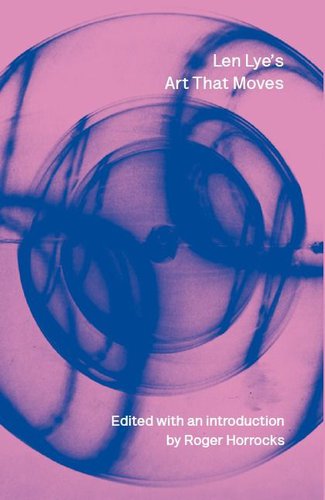John Hurrell – 2 January, 2024
A natty attractive little book, this ‘taster' features great design decisions from Kalee Jackson, including a gorgeous cover. It is a worthy companion to two previous small Lye books also published by the Govett in partnership with the LL Foundation: 'Poems Len Lye' (2021), and with Robert Graves, 'Individual Happiness Now' (2017).
Len Lye and Roger Horrocks
Len Lye’s Art that Moves
A small anthology of Horrocks and Lye writings (with diagrams and photographs) discussing a selection of key kinetic Lye works
Preface by Roger Horrocks, its editor and contributor
Design: Kalee Jackson
Softcover 72 pp
Govett-Brewster Art Gallery and Len Lye Centre, 2023
This pocket-sized publication is a precis of the earlier and much thicker & wider Art that Moves: The Work of Len Lye (2009)—but using more of Lye’s own words and without the DVD—and so is a charming and brief introduction. Horrocks, of course, is well known for his superbly detailed Lye biography, and like his friend Wystan Curnow, a tireless champion of Lye’s art and texts.
A natty attractive little book, this ‘taster’ features great design decisions from Kalee Jackson, including a gorgeous cover. It is a worthy companion to two previous small Lye books also published by the Govett in partnership with the LL Foundation: Poems Len Lye (2021), and with Robert Graves, Individual Happiness Now (2017).
Apart from Horrocks’ exceptionally lucid lead-in to Lye’s art practice and body-conscious / empathetic-movement philosophy, the booklet presents notes (with images) on nine Lye kinetic steel sculptures, putting aside temporarily his profound contributions through ‘scratch’ film. It also presents Lye’s important 1964 essay, The Art that Moves, a sort of manifesto.
On a personal level, I consider myself reasonably familiar with most of Lye’s sculptures, having worked in the nineties as part of the Govett team—and following later developments—but in this book I found images of three works I regret not ever bodily encountering: Zebra (1965 [2009 reconstruction]), Convolutions (2021) and Water Whirler (2006). So I was very pleasantly surprised to read of them further.
Convolutions, as an undulating ‘wall drawing’ reminiscent of a wobbly, moving, cartoon speech-bubble, in particular seems fascinating as a comment on the organic ‘liveness’ of spoken language, and the adaptability of any phrases for almost any use. The work seems to indicate how verbalised expression—or even solely written—can’t be strictly controlled or rigorously limited for set semantic purposes. One can try and define ‘tone of voice’ or ‘contextual background’—all to no avail.
Like the other two in the series, this is a great little paperback, beautifully put together, and a typical example of Roger Horrocks’ awesomely inexhaustible energy.
John Hurrell

 Advertising in this column
Advertising in this column Two Rooms presents a program of residencies and projects
Two Rooms presents a program of residencies and projects



This Discussion has 0 comments.
Comment
Participate
Register to Participate.
Sign in
Sign in to an existing account.